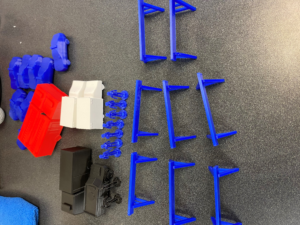EMRTC is enhancing course materials via Interactive 3D visual aids that engage participants.
The 3D printed models would allow participants to visualize emergency scenarios with more detail. Two different types of models are being used. One is 3D modeling, which shows a 3D representation of an object digitally. 3D printed objects are modeled digitally then printed; these pieces can resemble vehicles, people, and other objects. Implementing these tools creates an engaging classroom experience.
Haley Hanson is the Media & Accessibility Specialist at EMRTC. Hanson designs 3D computer models of improvised explosive devices (IEDs). Hanson mentioned “3D models allow us to be more detailed”. The Switch, Initiator, Main Charge, Power, Container, Enhancements (SIMPCE) model, which is used in courses, demonstrates components found in IEDs. The model can be spun around and viewed from different angles, allowing participants to have a better understanding of the device and use this knowledge to recognize an IED in the field.
With detailed models, the participants can gain a better understanding of the components of an IED they are looking for in an incident. Each component is shown in detail from different angles, including the batteries used.
Hanson highlights the importance of knowing the composition of a battery and the amount of detail that is required to understand the complexities of the battery, especially after an explosion.
“Most adults are familiar with what a battery looks like, but not what a decimated battery looks like post explosion”.
On Zoom participants can look at the model as the instructor is discussing different aspects of the model. Participants are given more information through a 3D model rather than only a lecture.
The SIMPCE model gives participants more details than just a picture can. The more information that can be provided for the first responders, the more prepared they are.
Another way EMRTC courses are being enhanced is through the use of 3D printed models that represent board game pieces like police and ambulances.
Jared Upshaw, a UAV pilot for EMRTC, also designs the 3D printed board game-like pieces. Instructors can create different emergency scenarios for participants to solve, almost like a puzzle.
In an interview Jared mentioned the 3D models “help the participants visualize the scenario better and… be strategic when choosing where pieces should go”.

The pieces can be easily manipulated to the needs of the different courses offered at EMRTC. For example, the pieces can represent vehicles, police, and other everyday objects. The instructor can design different emergency scenarios that the participants must overcome using 3D printed models. This creates hands-on activities that enhance the course.
During course lectures, participants can view 3d models as the instructor describes each component, enhancing the experience rather than only showing images. After the course the model is available to the participants as a download.
